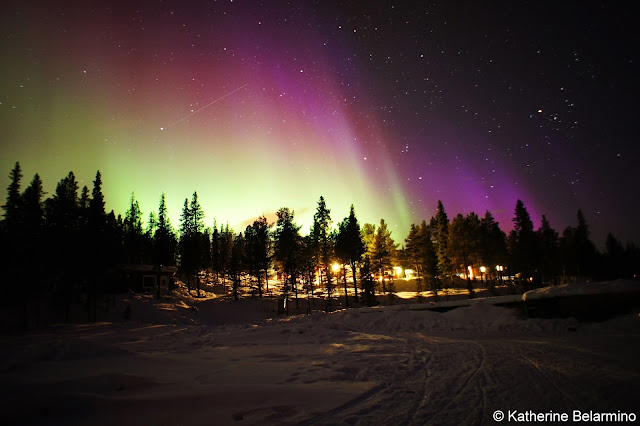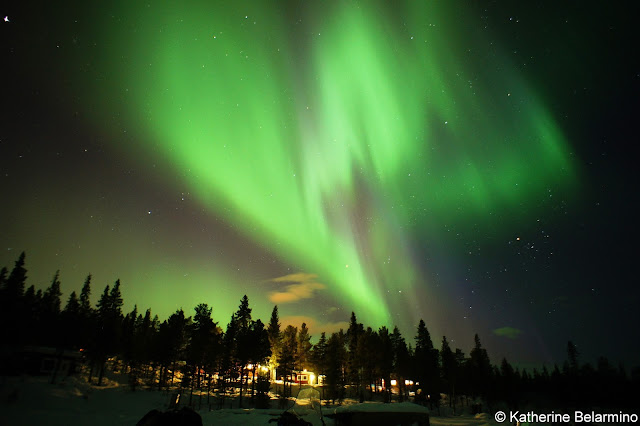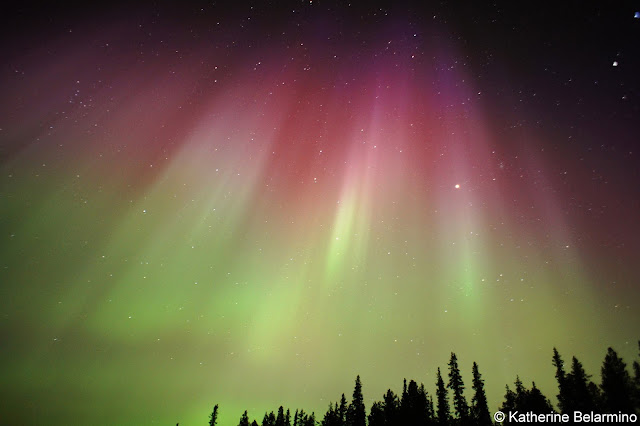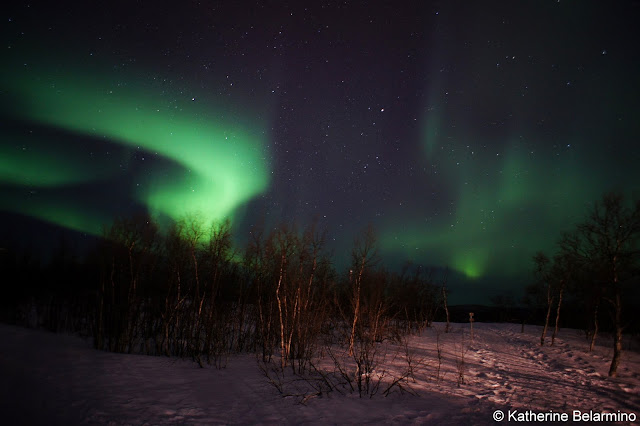When we told people we were traveling to Sweden in March we were asked, “Isn’t it still cold there?” The answer was yes, it was cold. In fact, it was very cold where we were planning on going, because we were heading above the Arctic Circle to Swedish Lapland. There was a reason we were going to spend four nights in below freezing temperatures—the Northern Lights. Come hell or high-water, I was going to see and photograph the famous Northern Lights . . . if I was lucky.
Our Northern Lights Story
I was under no misapprehension that a Northern Lights sighting was guaranteed. I had been researching seeing and photographing the Northern Lights, including the recitations of fellow travel blogger Jennifer Dombrowski, Luxe Adventure Traveler, about her chase of the Northern Lights, especially her 5 Things No One Ever Tells You About the Northern Lights. I had found in my research that Swedish Lapland above the Arctic Circle was one of the best places in the world to see the Northern Lights, or Aurora Borealis.
As soon as we decided on Sweden as our travel destination, I obsessively began watching Lights Over Lapland’s Facebook page for aurora photos and news. A couple weeks before we were scheduled to leave I saw posts like these:
We are absolutely blown away by how many powerful displays we have seen this season! 2014 - 15 may be remembered as the best aurora season of all time!Video: Lights Over Lapland photographer Chad Blakley
Posted by Lights Over Lapland on Friday, February 27, 2015
I was excited, but also worried that these spectacular auroras would pass before we got to Swedish Lapland.
When we arrived in Jukkasjärvi I neurotically checked my Aurora Forecast app, an Aurora Service website with an hourly forecast, the Aurora Sky Station web cam, and the AccuWeather.com cloud forecast.
When we arrived in Jukkasjärvi I neurotically checked my Aurora Forecast app, an Aurora Service website with an hourly forecast, the Aurora Sky Station web cam, and the AccuWeather.com cloud forecast.
Our first night in Jukkasjärvi, March 16, was supposed to have very low aurora levels, but according to the weather forecast that night was going to be the clearest night of our four nights in Swedish Lapland. This was also the day we were spending the night in an ICEHOTEL cold room. We sat in the dressing room of the ICEHOTEL, falling asleep occasionally and heading outside every half-hour in hopes of seeing some small glimmer of green light in the sky. It wasn’t until we had given up and were getting ready to head to our ice bed around 1:30 a.m. that I saw the tiniest bit of movement in the sky. It was barely anything, but it was my first ever sighting of the Northern Lights and I was worried that was all I was going to get.
 |
| I was worried these were the only Northern Lights we would see. They're not much to write home about. |
Lights Over Lapland runs Northern Lights photography tours where they provide cameras for guests which are already set up to capture the Northern Lights plus a professional photographer to ensure everyone gets the perfect shot. When planning our trip I had tried to schedule our tour with Lights Over Lapland on March 17, but had to book March 18 instead because they were full March 17. Looking at the weather, it was supposed to be completely cloudy where we would be that night, and I was sure by not getting on that tour we were going to miss the opportunity to see what might be the best light show of the year. Then the Facebook posts and tweets and emails started coming in from friends who were wondering if we were going to see the insane Northern Lights show that was all over the news because they were going to be visible in places like West Sweden, England, Michigan, Wisconsin, Washington, Illinois, New York, and even as far south as Texas and Georgia, places that almost never see the Northern Lights.
With heavy hearts, we set out on our snowmobile aurora expedition that evening with Kiruna Guidetur. I had chosen that tour because I wanted to plan activities that would be fun even if the Northern Lights didn’t show themselves. Our guide Finn said he had been looking at the weather and it looked like the skies might actually clear up where we were heading. I figured he was just trying to instill some hope in us, but kept an anxious eye out just in case.
We rode through silent darkness across the white snow illuminated only by the headlights from our snowmobiles. As we drove along I would see the occasional twinkle of a star in the sky, an indication that the clouds might actually be clearing up. About halfway to our destination Finn motioned for us to stop. Up in the sky, we could see what looked like a moving milky cloud. It was the Northern Lights! Even without a tripod, I was able to take my first real picture of the Northern Lights. I told Rome that if this was all we saw, we were lucky. Little did we know what would happen next.
 |
| We would have been happy with just this glimpse of the Northern Lights. |
 |
| Our Northern Lights show started with pink. |
 |
| The Northern Lights moved and changed to shades of orange. |
So what can you do to at least up your chances of seeing the Northern Lights and stave off disappointment?
Travel to the Best Places to See the Northern Lights
 |
| Shooting star or satellite? |
Travel When the Northern Lights Can Be Seen
This probably goes without saying, but the Northern Lights can only be seen when it is dark outside, so while there may be aurora activity during the summer, you aren’t going to be able to see it. In Swedish Lapland, the aurora season is October through March. We chose March because there are daylight hours, so we were also able to enjoy daytime outdoor activities in Swedish Lapland, and warmer temperatures (20 degrees Fahrenheit instead of -20).
Plan Non-Aurora Related Activities
 |
| If we hadn't seen the Northern Lights, we still would have had fun snowmobiling. |
Know What to Expect About the Northern Lights
 |
| The Northern Lights even look different on different cameras. |
Set Yourself Up for Successfully Photographing the Northern Lights
 |
| Mother Nature sent a heart for our broken-hearted companion. |
A decent camera with manual settings is essential for capturing the Northern Lights in photos. The other essential is a tripod. Perhaps not as essential, but right up there, is to bring two batteries. It is astonishing how quickly cold weather drains a battery. On our second night of auroras I had to change my battery halfway through the show.
If you don’t have a tripod and good camera with manual settings and don’t want to invest in them, join a photo tour like Lights Over Lapland. These tours provide DSLR cameras and tripods for each guest and all you have to bring is a memory card. Also join a photo tour if you do have the right tools but don’t feel like you have the right knowledge of your camera to capture the Northern Lights.
If you do have the essential tools for photographing the Northern Lights on your own, here are photo tips we gathered from our personal experiences.
- Set your camera’s focus to infinite, or focus on something as far away as possible. It is easy to forget this step in the excitement, but if you don’t set the focus, your photos will be blurry.
- Set your ISO to the lowest number that will still allow your image sensor to capture an image (see below for examples as this number can vary depending on the camera’s capabilities). The lower the ISO, the less graininess (noise) your photo will have.
- Set your f-stop to the lowest number possible. The smaller the number, the more light that is let into the lens, which provides a better picture with the shutter being open as short of a time as possible.
- Set your shutter speed for the optimal time based on the brightness of the Northern Lights. While you can pretty much leave your focus, ISO, and f-stop alone once set, the number of seconds you will keep your shutter open will change depending on the brightness. We used anywhere from eight to 30 seconds. This is why a tripod is essential.
- Use a wide-angle lens if possible. The more of the sky and landscape you can get into the picture, the better.
- Take off that lens filter. If you use a filter on your lens, you might come home, go through your pictures, and find that in the center of your beautiful Northern Lights photos there is a circular pattern that almost looks like a fingerprint. It has something to do with the spectral emissions of the aurora and the parallel faces of the filter and other scientific sounding words. Bottom line, lose the filter.
I have always loved my Sony NEX-3. Sony makes mirrorless cameras which I have always believed give standard DSLR cameras a run for their money, and in the case of the Northern Lights, leaves comparably priced DSLRs in the dust, in my humble opinion. The Sony mirrorless camera combines the best of both worlds, the interchangeable lenses and photo quality of a standard DSLR, and the fun computerized settings of a point-and-shoot. My camera is an earlier generation, but the current Sony mirrorless camera is the Sony Alpha a7IIK. (Since writing this article I have purchased the Sony a7II and can highly recommend it. Hopefully I will have the opportunity to test it out on the Northern Lights in the future.) Here are the settings I used with my Sony NEX-3:
ISO: 800
F-stop: f/2.8
Lens: 16mm
Exposure: 8-30 seconds
If you’re not ready to jump onto the mirrorless camera bandwagon with me, DSLR is the way to go.
Rome used his Canon EOS Rebel T1i with the following settings:
ISO: 400 and 800
F-stop: f/4 and f/5.6
Lens: 10-18mm
Exposure: 8-30 seconds
Finn, our Kiruna Guidetur guide, had a Canon EOS 60D (the latest version is the Canon EOS 70D) and used the following settings:
ISO: 1280
F-stop: f/4
Lens: 18-135mm
Exposure: 8-30 seconds
During our Lights Over Lapland aurora photo tour, we used Nikon D5100 cameras (replaced by Nikon D5300) with the following settings:
ISO: 1600
F-stop: f/3.5
Lens: 18-55mm
Exposure: 15 seconds
Of course if you’re a professional photographer with lots of money, you’re probably packing something far more advanced than the cameras listed above (and are hopefully not terribly offended by my over-the-top endorsement of mirrorless cameras). The cameras I've listed are for travelers who want more than a point-and-shoot, but don’t necessarily have thousands of dollars to spend on cameras and equipment.
One more tip for successfully photographing the Northern Lights is to practice ahead of time. We took photos in our backyard before getting on the plane to Sweden so we could figure out the optimal settings for our personal cameras in a nighttime situation. When the Northern Lights appeared, we were all set except for focusing and choosing the correct exposure time.
Want a Northern Lights selfie? Very dim indirect light is the best. While out on the frozen Torne River, we tried using our phones to light up our faces, with results, but not the best results. We had the best luck when we were taking pictures of the auroras just outside our hotel in Kiruna, Camp Ripan, on our second night of amazing Northern Lights.. We stood in the adjacent park and let the indirect light from the hotel illuminate our faces. Be sure to stand as still as possible.
When I told a friend about our experience and how, even after we had arrived home, I still found myself peering anxiously up into the night sky, she said that's what children do, and isn't that a wonderful thing to have that feeling back. She was right. The Northern Lights are such an awe-inspiring phenomenon they draw up that wonderment and excitement we had as children about the little things in life. They remind us there are things in this world that may be hard to understand and should just be enjoyed when we are lucky enough to witness them.
Thank you to Lights Over Lapland and Kiruna Guidetur for hosting our Northern Lights tours and making this post possible. As always, all opinions are my own. Purchasing items through this article's affiliate links help fund our travels.










